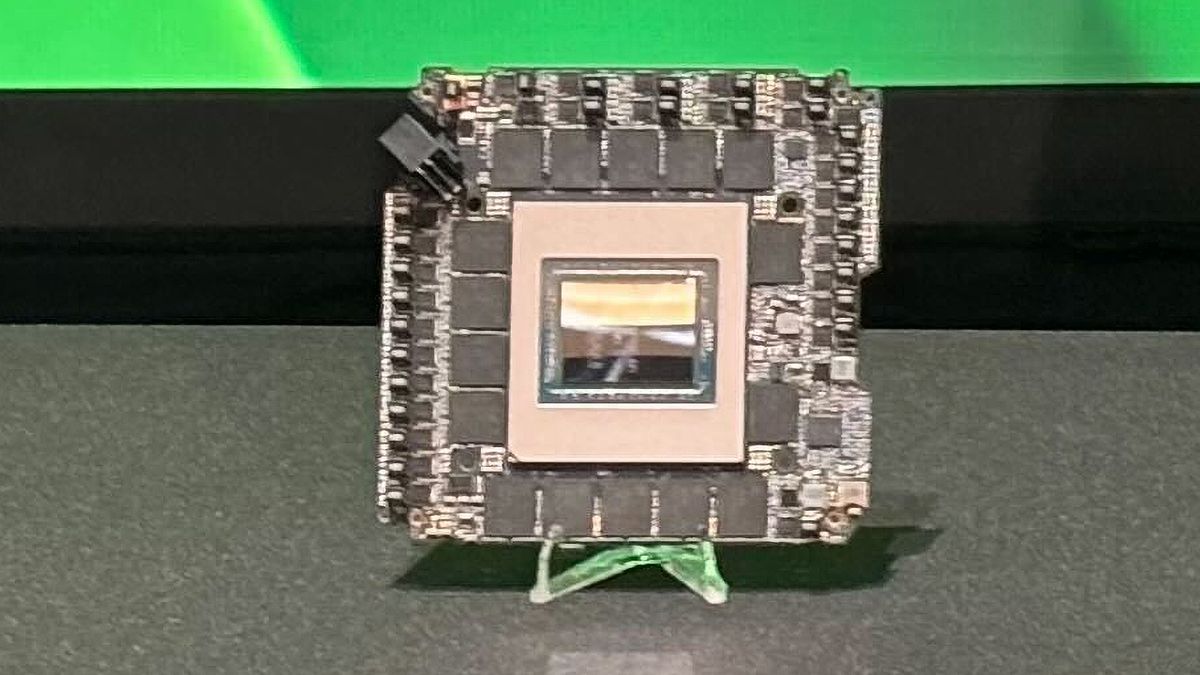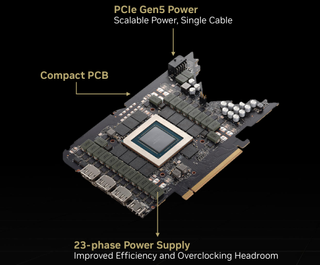Nvidia's powerful RTX 5090 PCB is amazingly small yet pumps 575W of power
The GeForce RTX 5090 Founders Edition has an unorthodox PCB design.

While Nvidia's GeForce RTX 5090 Founders Edition graphics card features the world's highest-performing consumer GPU released to date, it is also one of the most power-hungry GPUs ever made. As a result, Nvidia needed a completely new printed circuit board, so it developed a three-piece design that looks like nothing we have seen before. The main PCB carries the GB202 chip, memory, and a monstrous 30-phase voltage regulating module (VRM).
Nvidia says that the GeForce RTX 5090 Founders Edition, which promises to be the best graphics card, uses a 'unique three-piece PCB' design. At its CES 2025 presentation, the company only demonstrated the 'high-density' PCB carrying the massive 92 billion-transistor GB202 graphics processing unit, accompanied by 32 GB of GDDR7 memory connected using a 512-bit interface to the GPU.
Although the new GeForce RTX 5090 FE graphics board packs a massive amount of compute horsepower, its ‘main’ PCB is really small card compared to the GeForce RTX 4090 (pictured below). To get an idea of how big or small the new one is, take a look at the size of the memory chips (they come in a 14mm x 12mm package) and compare its size to the size of the previous generation product that features memory packages of exactly the same dimensions. We also have a picture of the old version further below.
The card has one 12V-2x6 power connector to deliver up to 55A of power to feed graphics cards drawing up to 600W on a 12V auxiliary rail. It also has a formidable 30-phase power delivery circuitry (up from a 23-phase VRM on the GeForce RTX 4090 Founders Edition). Given that Nvidia's GeForce RTX 5090 is rated for a 575W total board power (TBP), the usage of the massive 30-phase VRM is justified, as the GPU and memory need a lot of stable and clean power without spikes and drops to operate properly. Moreover, a more sophisticated power circuitry can increase the performance efficiency of a product. Yet, we can only wonder how much overclocking headroom these GeForce RTX 5090 boards with a single 12V-2x6 power connector will have.


The PCB lacks display outputs, power connectors for fans, and a PCIe grid, though it has additional connectors on the back. Therefore, we guess that the GeForce RTX 5090 Founders Edition card has two more boards that are not yet shown. We can only speculate why Nvidia would disaggregate display outputs, PCIe grids, and fan connectors from the main PCB.



One reason could be that each PCB was designed with a specific purpose in mind, enabling cleaner signal routing and more efficient use of space. Also, separating display outputs, PCIe, and fan connectors could minimize electrical noise and improve the stability of power delivery to the GPU.
Nvidia could also take a page from its own GeForce 8800 GTX/Ultra (the G80 GPU) book and disaggregate display engines from the GB202 GPU to save precious silicon footprint for compute and optimize overall GPU design. Perhaps this would enable Nvidia to offer different GB202 products by mixing and matching external modules. For example, a GB202-based card sitting in a server does not need display outputs, whereas some OEMs could offer their clients a different display output configuration.
Stay On the Cutting Edge: Get the Tom's Hardware Newsletter
Get Tom's Hardware's best news and in-depth reviews, straight to your inbox.

Above, we can see the larger old PCB. Although the new GeForce RTX 5090 FE graphics board packs a massive amount of compute horsepower, its ‘main’ PCB is a really small card compared to the GeForce RTX 4090.
An interesting thing to note is that Nvidia's partners will continue to use single-board designs for GeForce RTX 5090 graphics cards. So, the unique three-piece PCB is not a mandatory requirement for range-topping Blackwell graphics cards, but rather a deliberate design decision by Nvidia's engineers, who had their own reasons for using such an unorthodox design.

Anton Shilov is a contributing writer at Tom’s Hardware. Over the past couple of decades, he has covered everything from CPUs and GPUs to supercomputers and from modern process technologies and latest fab tools to high-tech industry trends.
- Paul AlcornManaging Editor: News and Emerging Tech
-
TCA_ChinChin I'll give it to Nvidia, their FE models have been getting really good. Will be interesting to see how the output ports fit with the main PCB through the actual cooler.Reply -
Hooda Thunkett For some reason, when it was mentioned that it's using 3 pcbs, I thought of fractal cards. The motherboard connects to the i/o card, the i/o card connects to the GPU card, the GPU card connects to the memory card...Reply
Not likely, but I kind of like the idea. -
jkhoward I suspect the display outputs aren’t on the board so they can use this PCB in other server/AI SKUs and save money.Reply -
ekio You add an grace based arm cpu on the die with a few extra mm2, add some more ram on the other side of the pcb, a PSU under, a cooling system above and boom, you have the ultimate PC Mini, screwing any 20kg desktop tower in the world.Reply -
spongiemaster This design looks like it will not play nice with water blocks. Could be the first Nvidia generation where water cooling users are better off going with something besides the FE model.Reply -
Lucky_SLS Replyekio said:You add an grace based arm cpu on the die with a few extra mm2, add some more ram on the other side of the pcb, a PSU under, a cooling system above and boom, you have the ultimate PC Mini, screwing any 20kg desktop tower in the world.
Nvidia did say that it has plans for the consumer PC CPU side with mediatek. What you said could very well happen in the near future.
And I can picture them asking 3k for the Nvidia mini PC, which has a 5080 in it ! -
WonkoTheSaneUK Reply
Indeed.spongiemaster said:This design looks like it will not play nice with water blocks. Could be the first Nvidia generation where water cooling users are better off going with something besides the FE model.
Several of the usual suspects have already announced both AIO-cooled cards & waterblock-already-fitted cards for custom loops.